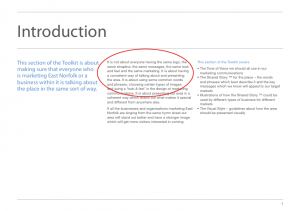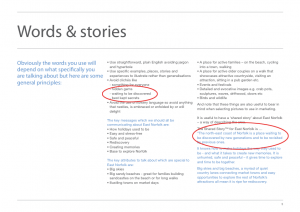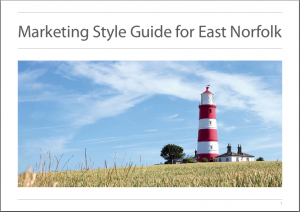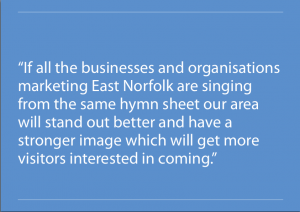Plain English Patrol 2
A while ago, I was asked to write some free sample copy as part of a tender for North Norfolk District Council. Against my better judgement, I complied. And, against more travel-focused writers (presumably), I didn’t win the contract.
But it wasn’t my fault. Because, to help me in my work, I was sent the Marketing Style Guide for East Norfolk, part of the council’s Tourism Marketing Toolkit. (It’s all in the public domain – follow the link to download it as a PDF.)
Well, if a collection of documents can indeed be a toolkit, this style guide is far from the sharpest tool in it. Hope you like sour grapes…
Lord of all awkwardness
On page 2 of the guide, we find the following prologue set in large white type:
“If all the businesses and organisations marketing East Norfolk are singing from the same hymn sheet our area will stand out better and have a stronger image which will get more visitors interested in coming.”
The quotes are part of the copy as printed, although it’s not clear who’s speaking.
First, we need a comma after ‘sheet’, and ‘which’ should be ‘that’. And ‘hymn sheet’ might need a hyphen. (Typography freaks will also be itching to pull out the indent on the first line, so the quote mark sits outside the measure and the left-hand edge of the text is all in line.)
‘Singing from the same hymn sheet’ is one of those pictorial metaphors that gets used a lot in business, like running things up the flagpole, without necessarily making anything clearer. (‘Hymn sheet’ also suggests the sort of Christian-centric worldview that public-sector organisations are usually at pains to avoid.) I would just have said ‘communicating the same way’ or maybe ‘speaking with one voice’ for something a little more inspiring.
I’m not sure there’s a mahoosive difference between ‘stand out better’ and ‘have a stronger image’. And ‘get more visitors interested in coming’ is hella clunky. Couldn’t we just ‘attract more visitors’?
These changes, plus a few extra tweaks, give this new version:
“If everyone marketing East Norfolk speaks with one voice, our area will project a stronger image and attract more visitors.”
I’ll let you decide whether that’s better. If nothing else, the point size could have been made even bigger than it is, which is pretty big.
Look and fail
Now we move on to the introduction (page 3), which explains the purpose of the style guide… or does it?
It is not about everyone having the same logo, the same strapline, the same messages, the same look and feel and the same marketing. It is about having a consistent way of talking about and presenting the area. It is about using some common words and phrases, choosing certain types of images and using a ‘look & feel’ in the design of marketing communications. It is about presenting our area in a coherent way which [sic] draws out what makes it special and different from anywhere else.

My bold. (And their bad.) Is this about having the same look and feel, or not? (The presence of 18 pages of visual guidance later on suggests that it is.) And the reference to not having the same messages is perplexing, because two pages later we encounter a section covering ‘the key messages which [sic] we should all be communicating about East Norfolk’.
The inconsistency of the phrase ‘look and feel’ (with/without quotes, ‘and’/ampersand) just adds insult to injury. Who’s proofreading this text, Stevie Wonder?
Lowering the tone
Page 4 sets out the target tone of voice in a tolerably logical way. Arriving at page 5, however, we contend with the devil in the detail, as the guide gets down to specifics:
Obviously the words you use will depend on what specifically you are talking about…
Will they? This is going to be harder than I thought!
…but here are some general principles:
- Use straightforward, plain English avoiding jargon and hyperbole
- Use specific examples, places, stories and experiences to illustrate rather than generalisations
- Avoid clichés like – something for everyone – hidden gems – waiting to be discovered – best kept secrets
(My bold again, you’ll see why in a second.) Naturally, the brave officers of the Plain English Patrol can only approve of writing in a straightforward, concrete and original manner. But hope is cruelly crushed by the Shared Story™ – a sort of brand positioning statement that appears later on the very same page:
The north-east coast of Norfolk is a place waiting to be discovered by new generations and to be revisited by previous ones…
That’s right. A howling inconsistency is just waiting to be discovered – by anyone with a spare ten minutes to read this through before it’s published.

Quis custodiet ipsos custodes?
The rest of the document continues with similar teeth-on-edge slips and inconsistencies. Pages 23 and 24, for example, insert a possessive apostrophe for a plural (‘Explorer’s’), while page 25 features two (count ’em) different misspellings of ‘existing’ and page 26 misses the ‘s’ off the plural of ‘example’.
The whole affair generates profound ambivalence about the whole concept of managing or controlling written tone of voice. If brands can’t get their own writing guidelines sorted out, then really, what hope is there? And where does it leave those who are supposed to be working for those brands?
I wish this were an isolated instance, but it’s not. Check out this post for another example (also from the public sector). Even thought leaders aren’t immune – check out M&C Saatchi telling us all about Brutal Simplicity of Thought while using apostrophes for decades (e.g. ‘1950’s’).
On the one hand, I welcome anything that implies or encourages respect for the writing process, and places it at the centre of marketing activity. But on the other, I worry that poorly thought-through or inaccurate guidelines could simply end up hindering (and irritating) the keenest and most capable servants of a brand. Foisting shonky guidelines on your marketers leaves them caught between attempting to comply and having to point out your mistakes.
My humble suggestion would be that brand owners might consider when it might be worth listening to their writers, instead of trying to police them.
Comments (6)
Comments are closed.


I object to the use of the word “mahoosive” and the expression “their bad”. I am not affiliated with North Norfolk District Council.
‘Special and different’ – a classic. Up there with ‘very unique’.
I suspect this sort of document is sent out without being proofread because management takes so long to decide what they want to include. Or what they think they need to include.
Methinks you’re lucky you missed out… 😉
And I love “mahoosive.” More of it, I say!
Unfortunately the kind of errors highlighted can be found in many government organisations. Thanks for introducing me to the word “mahoosive.” I might add it to my vocabulary.
Sooty?